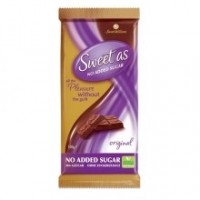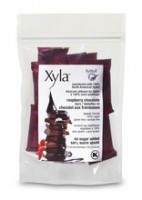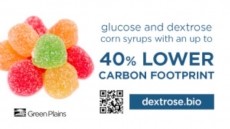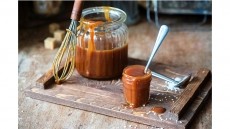Special Edition - Beyond sugar: Hitting the sweet spot
A bittersweet symphony for alternative sweeteners in chocolate

Barry Callebaut has touted steviol glycosides as the standout sugar alternative for chocolate. We’ve dedicated an entire article to the sweetener HERE.
We assess other possibilities growing in popularity including fibers, fruit extracts, fructose and xylitol.
Oh sugar! This isn’t as easy as we thought
Rinus Heemskerk, global director of innovation for ADM Cocoa, said that many manufacturers desired a chocolate free from sugar without fully appreciating the magnitude of the task.
“There are two functions in sugar. One is the sweetness and the other one is the bulking function. For the sweetness function there are ample possibilities. The tough one is to replace the bulking function. To find something which has the same behavior when you eat it as sugar is not all that easy.”
The common way: Maltitol
Barry Callebaut innovation manager Marijke De Brouwer said that the polyol maltitol was the most common sugar alternative in chocolate mainly because it was cheaper than other possibilities.
A 2006 study by Gunes et al. highlighted maltitol as the most effective polyol to replace sugar in chocolate. Heemskerk said that maltitol behaved very similarly to sugar.
“If you make a maltitol chocolate you have a product that almost tastes like chocolate, but a high percentage of polyols may be needed, which in itself may be a limitation.”
Manufactures are under a legal obligation in the EU to give an on-pack warning about the laxative effects of foods containing over 10% of polyols. Another of maltitol’s drawbacks is that is produced by hydrogenation so cannot be considered natural.
ADM on Fibers
“In general, people would be interested in replacing sugars by fibers because fibers have a double advantage,” said Heemskerk.
The ADM Cocoa R&D chief said that adding fibers would help to increase low fiber consumption in the Western world and would also allow a product with fewer calories.
ADM produces soluble fiber Fibersol that can be used to replace up to 25% sugar, providing mainly a bulking effect.
Asked if it would reduce costs, Heemskerk said: “No. It’s the more expensive solution, but you will definitely get a more healthy profile.” Manufacturers can make a fiber claim on the pack depending level on the level of replacement and the type of chocolate product.

Sensus’ Dietary fiber blend
Ingredients supplier Sensus claims its blend of soluble dietary fibers Frutafit inulin and Frutalose oligofructose, both derived from chicory root, are a natural combined solution to substitute sugar in chocolate.
Inulin can be up to 50% sweeter than sucrose, depending on the type. Sensus’ dietary fiber combination can be blended with high-intensity sweeteners to create a ‘low sugar’ or ‘no added sugar’ chocolate.
There are no restrictions for using inulin and oligofructose and according to Sensus both produce no laxative effect. However, consuming high amounts of inulin can lead to flatulence and bloating.
Fruits and natural sources
Other options include fruit extracts. Barry Callebaut’s Sweet by Fruits for example uses a blend of apple and grape extracts that are derived naturally using water. Sweet by Fruits acts as a like-for-like sugar replacement, fulfilling both the sweetness and the bulking function.
A chocolate product with Sweet by Fruits will contain 30% less sugar than a sugar-based product, but it still contains fruit sugars and cannot make a ‘no added sugar’ or ‘sugar-free claim’.
De Brouwer said that Barry Callebaut’s customers’ often say that chocolate sweetened with Sweet by Fruits has a honey flavor, but a similar color and texture to sugar chocolate.
The sweetener is an alternative to fructose, a common fruit sugar yet fully refined while Sweet by Fruits maintains the whole sugar profile of fruits.
A chocolate with Sweet by Fruits is slightly reduced in calories compared to a refined sugar product but not enough to make a claim in the EU. Sweet by Fruits is labeled “fruit extract” on product labels.
Fructose to reduce cocoa
Fructose is a natural sugar rather than a sweetener that is derived from either starch or sucrose. It provides only the sweetness and not the bulk.
Fernando Schved, VP strategic R&D and chief scientist at fructose supplier Galam said: ”You may have a bar which is on the outside a hard chocolate but on the inside you have kind of a creamy moisture which fructose can work very well with. “
“Fructose also has a very good tendency to work with cocoa flavors. If we take the average, it may help the food producer to reduce the amount of cocoa by maybe 15%. So it can help you also to reduce costs.”
Galam believes that fructose will get a boost in 2014 from a recently approved European Food Safety Authority (EFSA) health claim that allows products substituting 30% of glucose or sucrose with fructose to make a low blood glucose rise claim.
‘Interesting’ monk fruit
PIC CAPTION US vegan chocolate firm Nibmor uses no refined sugar in its chocolate products. It uses agave nectar in its chocolate bars, as well as maple sugar and syrup and coconut palm sugar.
“There’s also an interest in monk fruit. It’s an interesting intensive sweetener,” said Barry Callebaut innovation chief De Brouwer.
She said that monk fruit was perceived as natural. Monk fruit delivers just the sweetness, and manufacturers could use a similar blend of bulk sweeteners that they use for stevia, she said.
Xylitol and the cooling effect

North America’s largest xylitol supplier Xylitol Canada is currently reformulating its own xylitol sweetened chocolate.
“If you were to replace it [sugar] for instance with xylitol you would have the strong cooling effect that xylitol has and all of a sudden you have a very different product,” said ADM Cocoa’s R&D chief Heemskerk.
Julie Reid, vice president and director of sales of Xylitol Canada, told us that consumers enjoyed the initial cooling effect of xylitol and said no other ingredients were needed to mask the flavor. However, she conceded that xylitol chocolate was a more expensive solution.

















